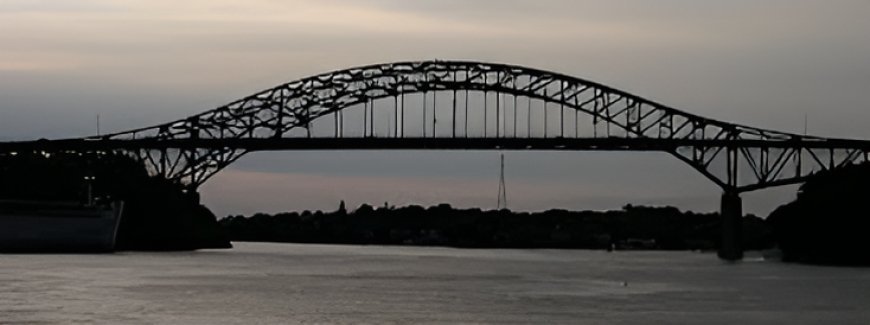Piscataqua River Bridge Closure | A Comprehensive Overview of the Incident

The Piscataqua River Bridge, a critical artery connecting Maine and New Hampshire, recently became the focus of significant concern due to an unexpected closure caused by an incident. The bridge is a vital infrastructure piece, supporting not only daily commuters but also the transportation of goods between the two states. This article provides a detailed account of the incident, the subsequent closure, and the implications for the surrounding communities.
Incident Overview: What Led to the Piscataqua River Bridge Closure?
On [insert date here], the Piscataqua River Bridge, a vital link between the states of Maine and New Hampshire, was abruptly closed due to an incident. According to reports, the closure was initiated after authorities were alerted to [specific details of the incident, e.g., a vehicle accident, structural concern, etc.]. This unexpected event prompted immediate action from local authorities, who prioritized the safety of all commuters and the structural integrity of the bridge.
The Piscataqua River Bridge is known for its significant traffic volume, with thousands of vehicles crossing daily. Therefore, the incident that led to its closure had a profound impact on the transportation network in the region. Emergency services, including police and transportation officials, quickly responded to the scene, coordinating efforts to manage the situation and ensure public safety.
Immediate Response and Traffic Management
In the wake of the closure, local authorities implemented several measures to manage the resulting traffic congestion. Detours were established, redirecting vehicles to alternative routes such as [mention specific alternative routes or highways]. Despite these efforts, the closure resulted in substantial delays, particularly during peak hours, as motorists were forced to navigate unfamiliar roads.
The New Hampshire Department of Transportation (NHDOT) and the Maine Department of Transportation (MaineDOT) collaborated closely to monitor the situation. They provided real-time updates to the public through various channels, including social media, local news outlets, and highway advisory radios. Commuters were advised to plan for extended travel times and to consider using alternative modes of transportation, such as carpooling or public transit, where available.
Impact on Local Communities and Businesses
The closure of the Piscataqua River Bridge had far-reaching effects on the surrounding communities. For residents and businesses in the area, the bridge is a critical link that facilitates not only daily commutes but also the movement of goods and services. The disruption caused by the closure led to concerns among local business owners about potential losses due to delayed deliveries and decreased customer traffic.
Local businesses that rely heavily on the bridge for their supply chain operations faced significant challenges. The transportation of goods between Maine and New Hampshire was particularly affected, leading to delays in shipments and increased costs for businesses that had to reroute deliveries. In some cases, businesses reported a drop in foot traffic as customers found it difficult to access certain areas due to the detours.
Structural Assessments and Safety Inspections
In response to the incident, structural engineers and safety inspectors were dispatched to the Piscataqua River Bridge to conduct a thorough assessment. Their primary objective was to determine the extent of any damage and to evaluate the overall safety of the bridge. This process involved detailed inspections of the bridge's support structures, roadway surfaces, and load-bearing components.
The inspection process was meticulous, as the safety of the bridge was paramount. Engineers utilized advanced diagnostic tools, including ultrasonic testing and ground-penetrating radar, to identify any potential weaknesses or damage that may not be immediately visible. These assessments are critical in ensuring that the bridge can safely reopen without posing a risk to the public.
Reopening Timeline and Long-Term Solutions
As of the latest updates, the timeline for the reopening of the Piscataqua River Bridge remains uncertain. The findings from the structural assessments will play a crucial role in determining the next steps. If significant repairs are required, the bridge may remain closed for an extended period, necessitating long-term traffic management solutions.
In anticipation of potential delays in reopening, local authorities are exploring options to mitigate the impact on commuters and businesses. These options may include the enhancement of alternative routes, the introduction of temporary traffic control measures, and the provision of additional public transportation services.
Community Support and Resources
During this challenging time, both state and local governments have emphasized the importance of community support. Resources have been made available to assist residents and businesses affected by the bridge closure. These include financial assistance programs for businesses experiencing economic hardship and transportation vouchers for residents who rely on public transit.
Additionally, community organizations have stepped in to provide support, offering services such as carpool coordination, delivery assistance for businesses, and informational hotlines for residents seeking updates on the bridge situation. The collaboration between government agencies and community groups has been instrumental in helping the region cope with the disruption.
Conclusion: Moving Forward After the Piscataqua River Bridge Incident
The closure of the Piscataqua River Bridge has highlighted the critical importance of infrastructure maintenance and emergency preparedness. While the incident has undoubtedly caused significant inconvenience, it has also underscored the resilience of the affected communities and the effectiveness of coordinated response efforts.
As we await the reopening of the bridge, it is essential for all stakeholders, including government agencies, businesses, and residents, to remain informed and engaged. By working together, we can minimize the impact of this incident and ensure a safe and efficient return to normalcy once the bridge is deemed secure.
For those impacted by the closure, staying updated on the latest developments is crucial. Local authorities will continue to provide real-time information, and we encourage everyone to follow official channels for the most accurate updates.
What's Your Reaction?



























